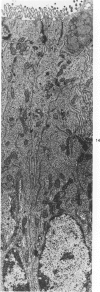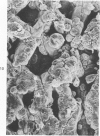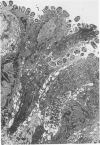Abstract
Transmissible murine colonic hyperplasia was examined ultrastructurally by sequential sampling after inoculation with the etiologic agent, Citobacter freundii. Light-microscopic changes in the descending colon of inoculated mice were correlated with scanning and transmission electron-microsopic findings. Bacteria were attached to the surface of the mucosa between 4 and 10 days after inoculation. Hyperplasia was most severe at 16 days and thereafter underwent regression. Regression was preceded by extrusion of infected cells from the surface mucosa and replacement by immature hyperplasia epithelium. Hyperplastic epithelium throughtout the crypt resembled undifferentiated crypt cells of controls. By 45 days, the mucosa had reverted to near normal structure. The results suggest that severe mucosal proliferation with minimal inflammatory change resulted from attachment of bacteria to the surface mucosal epithelium. The hyperplastic response appeared to be a defense mechanism of replacing infected cells with newly migrated, uninfected epithelium.
Full text
PDF







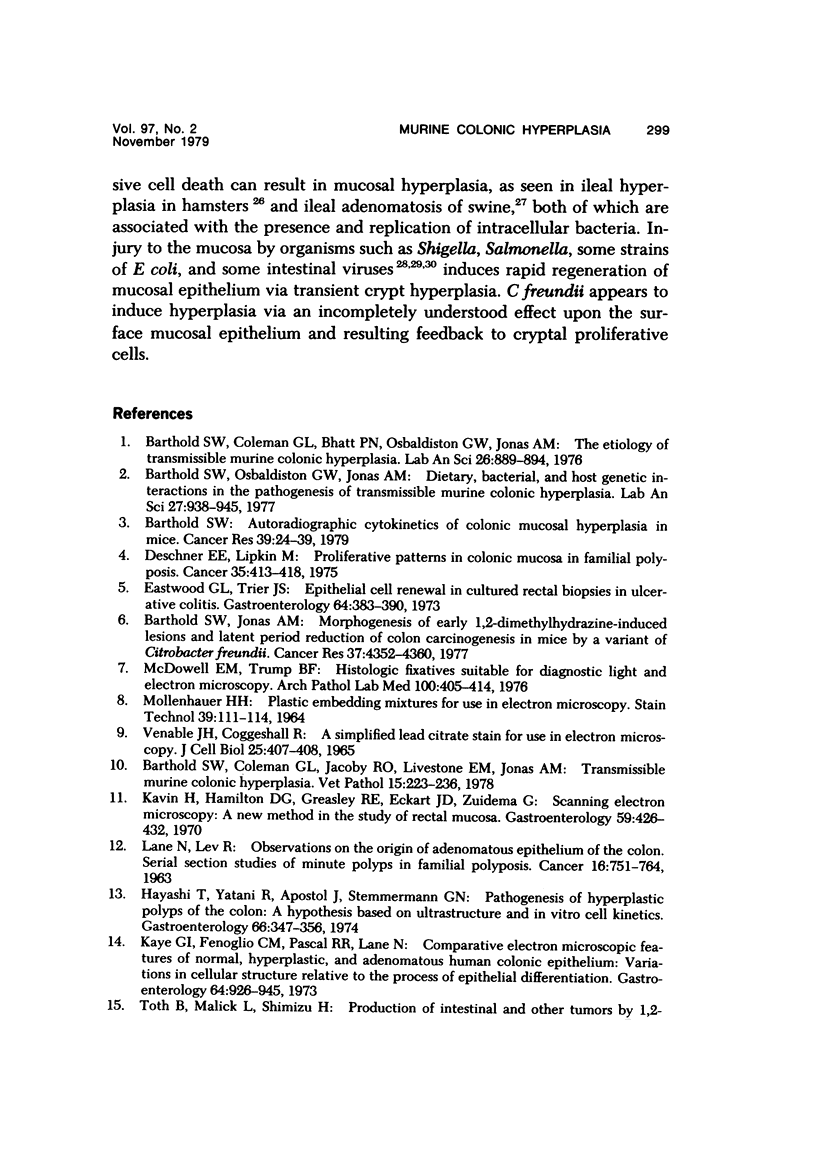











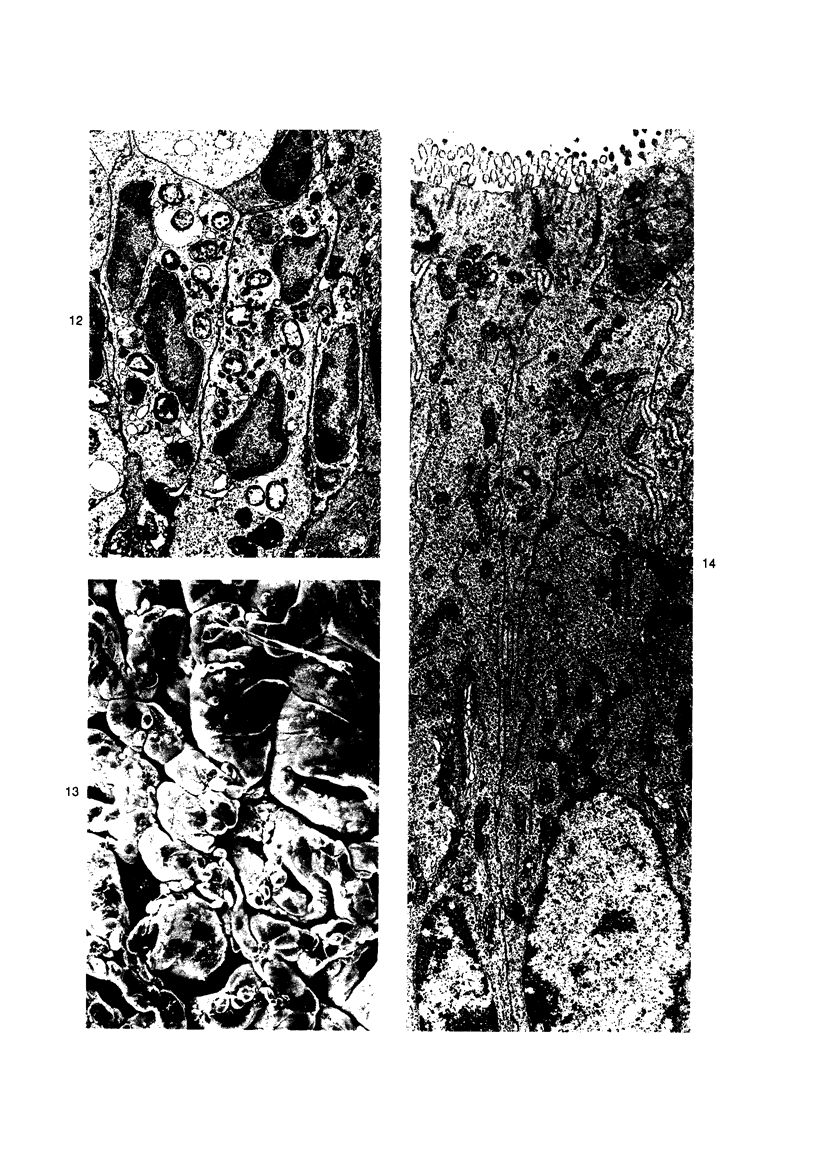
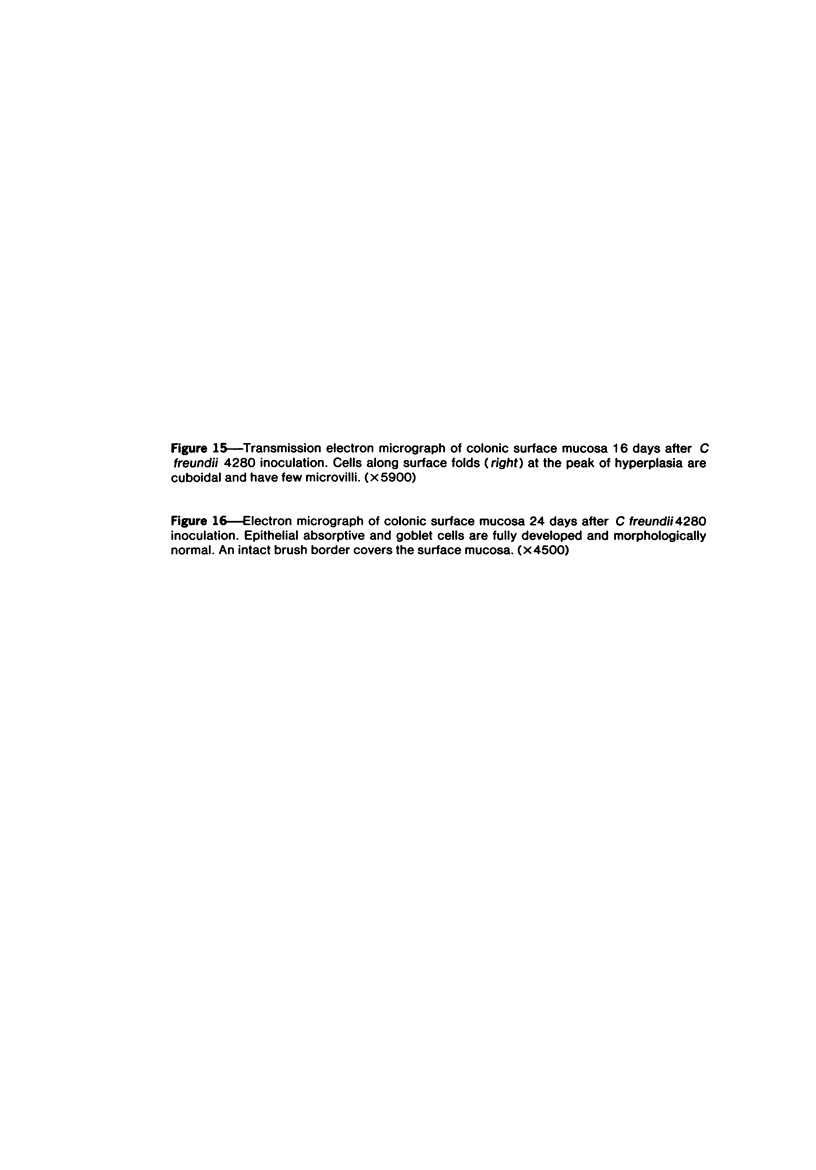

Images in this article
Selected References
These references are in PubMed. This may not be the complete list of references from this article.
- ABRAMS G. D., SCHNEIDER H., FORMAL S. B., SPRINZ H. CELLULAR RENEWAL AND MUCOSAL MORPHOLOGY IN EXPERIMENTAL ENTERITIS. INFECTION WITH SALMONELLA TYPHIMURIUM IN THE MOUSE. Lab Invest. 1963 Dec;12:1241–1248. [PubMed] [Google Scholar]
- BIGGERS D. C., KRAFT L. M., SPRINZ H. LETHAL INTESTINAL VIRUS INFECTION OF MICE (LIVIM). AN IMPORTANT NEW MODEL FOR STUDY OF THE RESPONSE OF THE INTESTINAL MUCOSA TO INJURY. Am J Pathol. 1964 Sep;45:413–422. [PMC free article] [PubMed] [Google Scholar]
- Barkla D. H., Tutton P. J. Surface changes in the descending colon of rats treated with dimethylhydrazine. Cancer Res. 1977 Jan;37(1):262–271. [PubMed] [Google Scholar]
- Barthold S. W. Autoradiographic cytokinetics of colonic mucosal hyperplasia in mice. Cancer Res. 1979 Jan;39(1):24–29. [PubMed] [Google Scholar]
- Barthold S. W., Coleman G. L., Bhatt P. N., Osbaldiston G. W., Jonas A. M. The etiology of transmissible murine colonic hyperplasia. Lab Anim Sci. 1976 Dec;26(6 Pt 1):889–894. [PubMed] [Google Scholar]
- Barthold S. W., Coleman G. L., Jacoby R. O., Livestone E. M., Jonas A. M. Transmissible murine colonic hyperplasia. Vet Pathol. 1978 Mar;15(2):223–236. doi: 10.1177/030098587801500209. [DOI] [PubMed] [Google Scholar]
- Barthold S. W., Jonas A. M. Morphogenesis of early 1, 2-dimethylhydrazine-induced lesions and latent period reduction of colon carcinogenesis in mice by a variant of Citrobacter freundii. Cancer Res. 1977 Dec;37(12):4352–4360. [PubMed] [Google Scholar]
- Barthold S. W., Osbaldiston G. W., Jonas A. M. Dietary, bacterial, and host genetic interactions in the pathogenesis of transmissible murine colonic hyperplasia. Lab Anim Sci. 1977 Dec;27(6):938–945. [PubMed] [Google Scholar]
- Deschner E. E., Lipkin M. Proliferative patterns in colonic mucosa in familial polyposis. Cancer. 1975 Feb;35(2):413–418. doi: 10.1002/1097-0142(197502)35:2<413::aid-cncr2820350217>3.0.co;2-b. [DOI] [PubMed] [Google Scholar]
- Eastwood G. L., Trier J. S. Epithelial cell renewal in cultured rectal biopsies in ulcerative colitis. Gastroenterology. 1973 Mar;64(3):383–390. [PubMed] [Google Scholar]
- Hampton J. C., Rosario B. The attachment of microorganisms to epithelial cells in the distal ileum of the mouse. Lab Invest. 1965 Aug;14(8):1464–1481. [PubMed] [Google Scholar]
- Hampton J. C., Rosario B. The attachment of protozoan parasites to intestinalepithelial cells of the mouse. J Parasitol. 1966 Oct;52(5):939–949. [PubMed] [Google Scholar]
- Hayashi T., Yatani R., Apostol J., Stemmermann G. N. Pathogenesis of hyperplastic polyps of the colon: a hypothesis based on ultrastructure and in vitro cell kinetics. Gastroenterology. 1974 Mar;66(3):347–356. [PubMed] [Google Scholar]
- Hohmann A., Wilson M. R. Adherence of enteropathogenic Escherichia coli to intestinal epithelium in vivo. Infect Immun. 1975 Oct;12(4):866–880. doi: 10.1128/iai.12.4.866-880.1975. [DOI] [PMC free article] [PubMed] [Google Scholar]
- Johnson E. A., Jacoby R. O. Transmissible ileal hyperplasia of hamsters. II. Ultrastructure. Am J Pathol. 1978 Jun;91(3):451–468. [PMC free article] [PubMed] [Google Scholar]
- Kavin H., Hamilton D. G., Greasley R. E., Eckert J. D., Zuidema G. Scanning electron microscopy. A new method in the study of rectal mucosa. Gastroenterology. 1970 Sep;59(3):426–432. [PubMed] [Google Scholar]
- Kaye G. I., Fenoglio C. M., Pascal R. R., Lane N. Comparative electron microscopic features of normal, hyperplastic, and adenomatous human colonic epithelium. Variations in cellular structure relative to the process of epithelial differentiation. Gastroenterology. 1973 May;64(5):926–945. [PubMed] [Google Scholar]
- LANE N., LEV R. Observations on the origin of adenomatous epithelium of the colon. Serial section of minute polyps in familial polyposis. Cancer. 1963 Jun;16:751–764. doi: 10.1002/1097-0142(196306)16:6<751::aid-cncr2820160610>3.0.co;2-0. [DOI] [PubMed] [Google Scholar]
- MOLLENHAUER H. H. PLASTIC EMBEDDING MIXTURES FOR USE IN ELECTRON MICROSCOPY. Stain Technol. 1964 Mar;39:111–114. [PubMed] [Google Scholar]
- McDowell E. M., Trump B. F. Histologic fixatives suitable for diagnostic light and electron microscopy. Arch Pathol Lab Med. 1976 Aug;100(8):405–414. [PubMed] [Google Scholar]
- Nagy B., Moon H. W., Isaacson R. E. Colonization of porcine small intestine by Escherichia coli: ileal colonization and adhesion by pig enteropathogens that lack K88 antigen and by some acapsular mutants. Infect Immun. 1976 Apr;13(4):1214–1220. doi: 10.1128/iai.13.4.1214-1220.1976. [DOI] [PMC free article] [PubMed] [Google Scholar]
- Rowland A. C., Lawson G. H. Intestinal adenomatosis in the pig: immunofluorescent and electron microscopic studies. Res Vet Sci. 1974 Nov;17(3):323–330. [PubMed] [Google Scholar]
- Sedlák J. Present knowledge and aspects of Citrobacter. Curr Top Microbiol Immunol. 1973;62:41–59. doi: 10.1007/978-3-642-65772-6_2. [DOI] [PubMed] [Google Scholar]
- Staley T. E., Jones E. W., Corley L. D. Attachment and penetration of Escherichia coli into intestinal epithelium of the ileum in newborn pigs. Am J Pathol. 1969 Sep;56(3):371–392. [PMC free article] [PubMed] [Google Scholar]
- Takeuchi A. Electron microscope studies of experimental Salmonella infection. I. Penetration into the intestinal epithelium by Salmonella typhimurium. Am J Pathol. 1967 Jan;50(1):109–136. [PMC free article] [PubMed] [Google Scholar]
- Takeuchi A., Formal S. B., Sprinz H. Exerimental acute colitis in the Rhesus monkey following peroral infection with Shigella flexneri. An electron microscope study. Am J Pathol. 1968 Mar;52(3):503–529. [PMC free article] [PubMed] [Google Scholar]
- Takeuchi A., Sprinz H., LaBrec E. H., Formal S. B. Experimental bacillary dysentery. An electron microscopic study of the response of the intestinal mucosa to bacterial invasion. Am J Pathol. 1965 Dec;47(6):1011–1044. [PMC free article] [PubMed] [Google Scholar]
- Toth B., Malick L., Shimizu H. Production of intestinal and other tumors by 1, 2-dimethylhydrazine dihydrochloride in mice. I. A light and transmission electron microscopic study of colonic neoplasms. Am J Pathol. 1976 Jul;84(1):69–86. [PMC free article] [PubMed] [Google Scholar]
- VENABLE J. H., COGGESHALL R. A SIMPLIFIED LEAD CITRATE STAIN FOR USE IN ELECTRON MICROSCOPY. J Cell Biol. 1965 May;25:407–408. doi: 10.1083/jcb.25.2.407. [DOI] [PMC free article] [PubMed] [Google Scholar]
- Wilson M. R., Hohmann A. W. Immunity to Escherichia coli in pigs: adhesion of enteropathogenic Escherichia coli to isolated intestinal epithelial cells. Infect Immun. 1974 Oct;10(4):776–782. doi: 10.1128/iai.10.4.776-782.1974. [DOI] [PMC free article] [PubMed] [Google Scholar]
- Wilson M. R., Hohmann A. W. Immunity to Escherichia coli in pigs: adhesion of enteropathogenic Escherichia coli to isolated intestinal epithelial cells. Infect Immun. 1974 Oct;10(4):776–782. doi: 10.1128/iai.10.4.776-782.1974. [DOI] [PMC free article] [PubMed] [Google Scholar]














